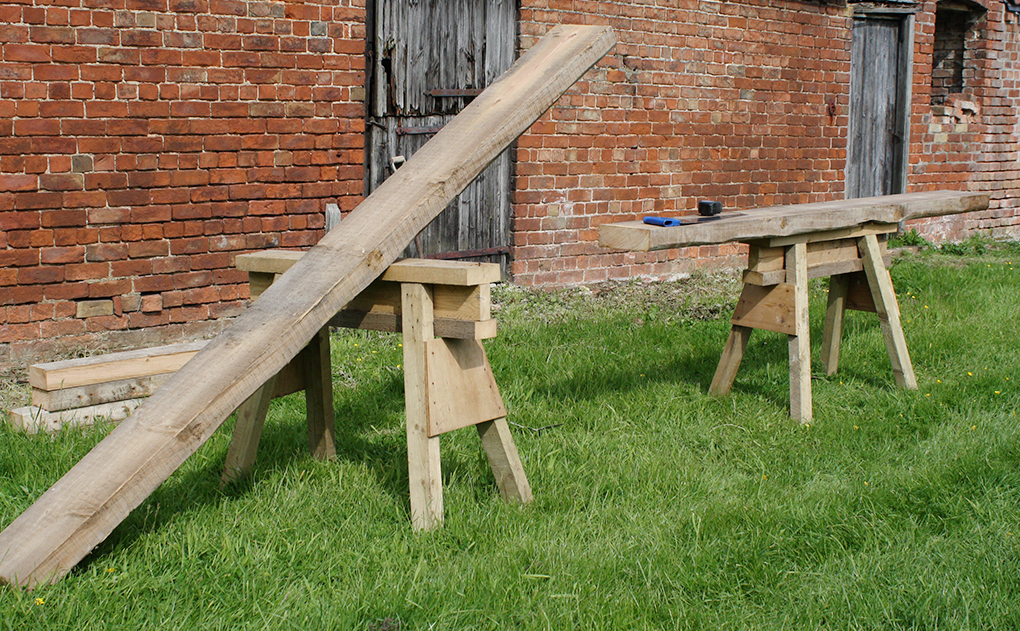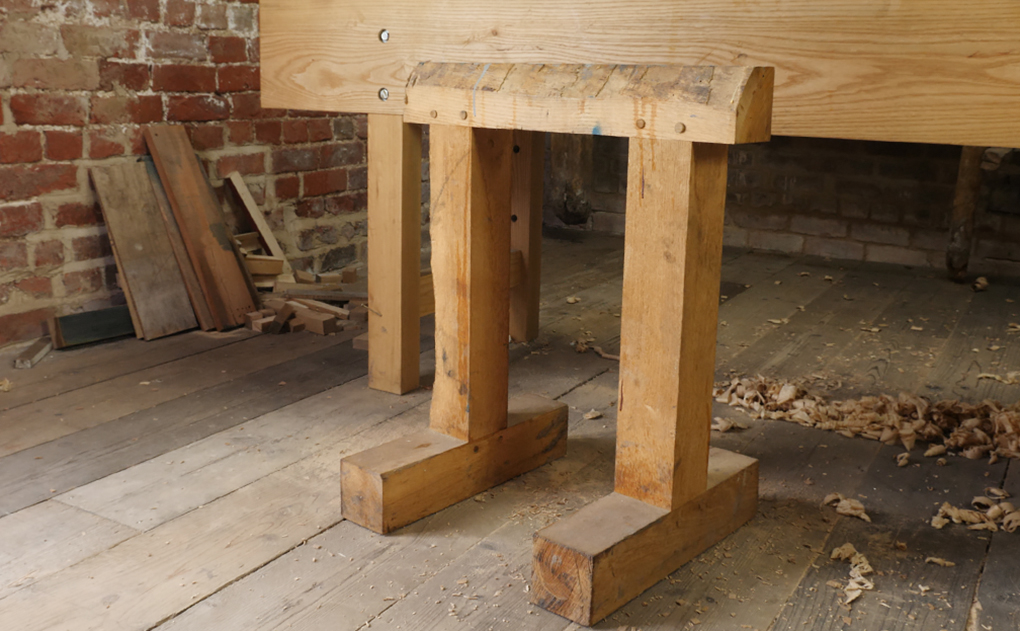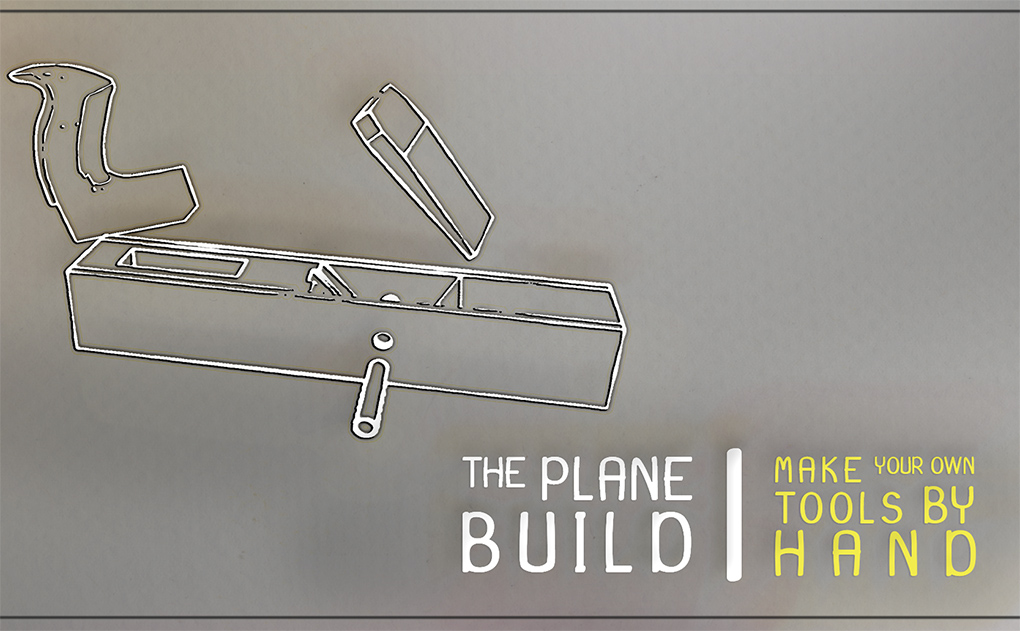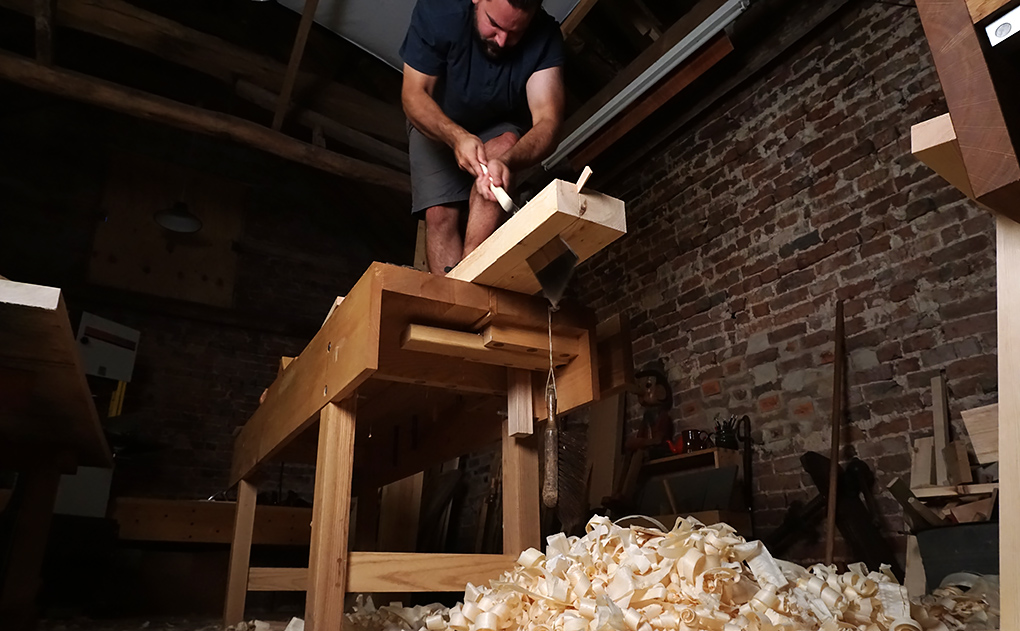Saw horses are a clat to get out and I’ll only use them if I have to (perhaps I’m lazy).
But of course they are extremely useful, and it’s nice to know there’s a couple stashed away ready to grab if needed.
Whether you need something cheap and nasty, or a sturdy work of art will depend on how they fit in with your workflow.
These days for me, saw horses are more of a thing where if I’m doing some donkey work outside they’re be set up. Offloading a timber delivery, working through a load of rough boards, that sort of thing.

Once I’m in the workshop, I very rarely leave the face of my bench. I’ll do all of my sawing off the workbench itself, it gives a continuous workflow, which is something I’ve never found you can get right using saw horses.
In this post I’m going to take a look at the types of jobs that I feel sawhorses are handy for, and give some thoughts on what I find to be the best design.
Saw Horses In The Workshop –
The Portable Workbench
When I was building workbenches, saw horses were used a huge amount in my work.
They were my workbench.
Everyone can benefit from them now and then, but when you’re building a workbench they become much more than a support for sawing.
In fact if you don’t have a proper workbench, then a couple of sturdy trestles make for a pretty good impromptu set up for any job.

Building a workbench off a couple of sturdy saw horses
With our bench building business a few sets of sawhorses allowed the best use of a rather small space.
I’d have several builds on the go at once, build the top off the saw horses, then build the base off the top (which was still on the saw horses).
Once the builds were complete, they were all stacked out the way, giving an empty space for the rough prepping to start over.
If you’re in the process of building yourself a decent workbench then you don’t need anything fancy for your saw horses, some plastic trestles will do.
You’ll work off them for the build, but once that’s complete you’ll barely need them at all.
There are a few exceptions though when having some good saw horses can be a real help.
The Stackable Assembly Table
Something I do still appreciate a decent pair of saw horses for is when I’m building extra large projects.
If I’ve got a great big dining table to build, then I may do a glue up on them. And I don’t need to be precious about getting glue dripped all over (which happens a lot).
Once again, they’re like an impromptu workbench that comes out when needed, but takes up little room when they aren’t.
So they definitely come in if you build lots of large projects.
Another time is if I want to keep my bench in action whilst I have something waiting in the clamps.
For the vast majority of projects though they’re not essential. There’s certainly ways to deal with all of our cross cuts without them.
Working Without Saw Horses
When it comes to cross cutting your timber, the key to working without saw horses is in how well your workbench is set up. It comes back to that one vice thing.

Without a tail vice, the workbench can be used for all cross cutting
If you don’t have a tail vice, then you can saw off the end of the workbench. I prefer this as it streamlines the whole motion of working.
For dead long lengths this might not be practical, particularly in a small workshop. But if space is at a premium and you don’t want to be storing extra stuff, then there are easy ways around it.
These days my workbench is positioned poorly for cross cutting. There’s not much overhang off that right end as the bench has been sat where it’s best for the cameras.
Sometimes I’ll rummage for the sawhorses, but I avoided this when we chopped the rough boards for the top of our Hall Table. They were great long lengths of cherry and I just cross cut them using a bench hook on top of the bench. This isn’t ideal and I had to saw a little closer to flat, but it’s quick for the odd couple of boards.

In our Hall Table build I cross cut the rough cherry boards to length on the bench top.
The Multi-Purpose Stump
You won’t have seen this in the current workshop, but something I used to do an awful lot was use my stump as a saw horse.
The stump is generally there for axe work but it’s unbelievably functional. Basically it’s a dead weight, so gives you the rigidity of the floor brought up to a practical height (knee height), and you never misplace it.
The Best Saw Horse Design?
If you’re looking at how to build your own then go get yourself some 3” square material and knock up a couple like my timber framing ones.
These are the best design in my opinion, all round practical and pretty straight forward to make.
They’re very grounded and are solid enough to mortice off which is nice.
I built mine for building workbenches off so they’re more chunky than you’d generally need. 3” (75mm) square material is plenty thick enough for furniture making.

A timber framing style trestle makes for the best saw horse. This one’s extra stout for bench building.
Personally I don’t like the splayed leg designs.
They’re ok if you’re looking for a couple of folding plastic trestles for cheapness, but if you’re building your own wooden set I’d avoid this design.
I find that the legs are constantly in the way; you’re always sawing in to one or clamouring over them.
And the splayed style of trestle rocks. You can correct it, but anytime you come back to them if there’s been a slight movement in the timber they rock again.
A part of filming that I hate is the tripods and they remind me of splayed leg saw horses. Like spiders – legs everywhere.
I rectified my tripod problem with monopods in concrete. That’s what a timber framing saw horse gives you.
Stackable or folding?
If you’ve got the space then saw horses are one of those things that you just want to leave out.
But that would cause a problem for me, because if they were left out I’d just start to store wood on them. And then tools on top of that wood.
The best thing about them is their ability to be shunted away when not required.
For real space saving the folding plastic ones are king, but for long term woodworking use they get wobbly fast.
I’d say everyone can benefit from having a pair of those plastic ones stashed away though. They fit in your car boot well for that occasional car park cutting action (although I normally just use a trolley).
If you go for timber framing trestles for something rigid to work off, then they will take up a little more space. It’s something to keep in mind, but they can slot together quite snuggly and take up a fairly small footprint.
What is a practical height?
Like most things, the best height depends on the use.
For sawing stuff to length – around knee height.
For working off – go a tad higher. (My timber framers are about 28″ tall.)
I’ve had a bit of a design floating around in my head for a while. I’ll call it the ‘Ultimate Knock-down Workbench, Workmate Type, Saw Horse System Thing’, that I really need to start playing around with.
We’ll talk about that one soon.

![Which Saws Are Best For Ripping Thick Stuff? [Video]](https://www.theenglishwoodworker.com/wp-content/uploads/2022/12/what-hand-saw-is-best-for-thick-rip-cuts.jpg)



Great post, thanks. Saw horses seem to provide a variety of uses that’s as wide as the variety of woodworkers. I like that aspect. They can become quite personal things. I use a three (vertical) legged horse and it comes in as the base for my shaving horse. The shaving horse is just a plank with swing and jaws at one end as usual. The plank just sits on the saw horse and I sit on the plank. In long sessions, I wish I had a saddle, but otherwise very functional. The plank bit just stores upright against a wall. As a saw horse it’s useful for the usual variety of jobs. And it’s a good seat for a cup of tea.
Very interesting Duncan, the multi use is an intriguing thought.
I’ve considered a lathe that attaches to saw horses so I can make a big heavy one that doesn’t take up space.
And how could I have forgotten the seat for the tea!
Did you ever publish any plans for the timber framing ones?
I think this is the closest: https://www.theenglishwoodworker.com/the-saw-donkey/
I only know this because I’m building some now. Cheers!
A pair of these donkeys just to the bottom of the kneecap is about perfect for both ripping and crosscutting. Sometimes I think a third would be helpful. Most of the time they reside in a corner.. built mine of lumberyard 3×3’s.
Thanks Josh, I though we’d covered something at some point.
There’s some dimensions on that post – it’s a bit scratty.
If you’ve got to buy wood to build them then fence posts would be perfect.
Thanks for this Richard and for the link to the saw donkey blog post Josh. My pair are finally built out of reclaimed fence posts – here’s to many years use and abuse!
That’s got me thinking Richard. My workshop is small at 4×3 metres but a single saw horse that fits under my bench and to match the height of a block for axe work could work really well.
That’s a clever thought. If the stump’s well located so it doesn’t have to be moved about then Bob’s your Uncle.
That would also make an ace set up for heavy morticing.
You are exactly correct about the splayed legs are like spiders with legs everywhere. I am currently working with my saw horses and I’m constantly tripping over the stinking legs. Timber framing saw horses are in my future, thanks for the idea.
Ha, I’m glad I’m not the only one.
You want to try camera tripods when there’s a load of money dangling on the top!
I’d say test a knee-high saw bench as well. Simply made and useful for dimensioning rough timber, cross cut, rip and diagonal, drilling holes, cutting deep mortises etc. Works as an extra table for the chisels when my bench is occupied by the lathe, or putting the coffe cup somewhere it will not be knocked over, sitting on for a break, while admiring your work, standing on so you can store things all the way to the ceiling…
You’ll make one in an hour and if you don’t like it, it is easy to take apart and burn.
So far I’ve only been using the workbench and don’t have any sawhorses yet. It’s worked pretty well for most things, but I’ve struggled with ripping, crosscutting bigger boards and when using the brace, so I’m contemplating building a Roman workbench (the type Chris Schwarz has reviewed and made). It seems like it could serve both as a sawhorse and as a convenient bench when chopping large mortises or when drilling. What’s your thoughts on this kind of ‘bench’, Richard?
Hi Henrik,
I’ve actually written a post on this somewhere, but haven’t got round to refining it to publish (it felt a little argumentative!).
But as a real short answer, I love the history side and I could certainly see it being ‘useable’, but there’s far better and easier options today when it comes down to both the approach to the build, and usefulness.
I believe that two well built timber framing saw horses, and a heavy plank on top would not only be a lot easier to build, but infinitely more versatile.
I do however have a complete an utterly hypercritical soft spot for the ‘Roman’ bench, so I could understand why if you choose to build it.
Great point. Obvious, really. I’m now going for those solid ‘saw-donkeys’. I guess the attraction of the Roman bench was the larger work area and having some holes for bench dogs and holdfast that I liked. Sort of what Jonas suggests.
My saw horses look a great deal like upside down buckets. It’s imperfect, but infrequent. For cross-cuts that don’t fit in the vise, it’s passable and I smile when I chuck the saw horses under the sink, out of the way. I like to rip vertically in the vise with two hands on the saw handle (there’s a reason for that funny notch on the top of the handle). When the rip gets too long for the vise, my saw horse looks a great deal like a band saw. I do own a pair of fold-up plastic sawhorses but there is a plank of wood across them that is buried under my lathe tools (my only other machine) and it would be a nightmare to fish out those horses. They are too tall for sawing anyway.
Ha, actually two buckets do make a really good saw horse. And you’re right, the plastic ones are too high for sawing, at least for a good ripping session.
Thanks Richard. Great approach on the topic.
Indeed, much of what you use in the workshop may not be so necessary. I think everything must be suited to the needs of each one. Avoiding little-needed objects can make work flow better.
Cheers!
I have had pretty good results from two very different designs of horse. At the cottage I use a couple of 4-foot x 20″ high splayed-leg ones (width and longways), with a 6″ wide top & extra-sturdy stretchers. The top has dogholes, & the stretchers double as quick steps up when the sawhorse wants to be a short ladder or scaffold. Good on rough ground & outdoor work. They live outside in all weathers.
The other set are Krenov style, made with 5/4″ thick material. The top bar is just set into a dry-pegged bridle joint. That lets me sacrifice & replace the top bar, or tweak the height (default is same as bench height), or use the lower crossbar to hold stuff. Making them was good mortising practice – the joints are wedged through-mortises. These extend the ‘length’ of the workbench for long stock or just hold stuff that would otherwise clutter the bench. I find these strong enough to hold whatever, and light enough to grab & move one-handed. Not beefy enough to mortise on though.
Yes, I do really need to get more disciplined about how many projects are “in progress” at a time.
You always make me laugh .in a B&Q car park cutting up some oak on a trolly . Lol .i have done it though .
Good day, Richard! There is one clever work mate like out of metal that can be used as a workbench when standing and as a saw horse when on its side:
https://www.youtube.com/watch?v=Uq1owp98Pj4
Also, I saw in some woodworking magazine idea of two stackable saw horses that I really liked. When stacked they have a height of a workbench and when not they both at a knee height. One of them had kind of a skirt around it where the other would stand on it when stacked. So that the height of the skirt defines the total height when they are stacked.
Thanks for the link, I love seeing peoples’ clever designs.
Hi! This is my first visit to your blog! We are a group of volunteers and starting a new project in a community in the same niche. Your blog provided us beneficial information to work on. You have done an outstanding job!
These are all lies and I love my sawhorses. Many upsetting things were said and I feel attacked.
Just kidding but starting out on my woodworking adventure I am just building two sawhorses from two old shipping pallets using Tom Law’s design from Fine Homebuilding and am very pleased with myself. My neighbour asked me what I was doing with them. I had no idea. These are sawhorses for sawhorses sake. I told him I needed them to construct a rocking horse but he seemed suspicious and might be onto me.